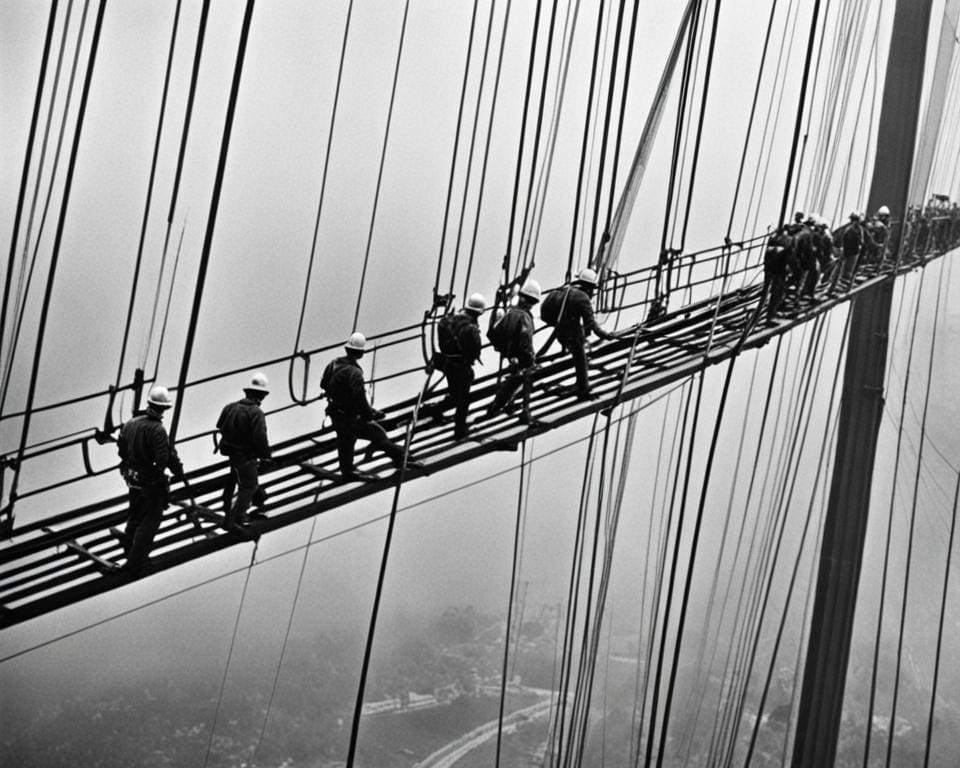The Golden Gate Bridge is a marvel in engineering, a key landmark in San Francisco. It draws millions yearly. Stretching 1.7 miles over the Golden Gate Strait, it links San Francisco to Marin County. Its unique International Orange color makes it stand out, making it a top spot for photographers worldwide.
Opened on May 27, 1937, the bridge has steered through many hardships. Today, it’s not just a crucial transport route but a symbol of human skill and determination. With its soaring height of 746 feet and cables reaching over 7,000 feet, it remains an awe-inspiring sight, loved by tourists everywhere.
History and Construction of the Golden Gate Bridge
The history of the Golden Gate Bridge is an amazing story of innovation, hard work, and victory. Starting in the late 19th century, the idea for a bridge over the Golden Gate Strait was a serious challenge. These challenges tested engineering boundaries of that time.
Initial Proposal and Challenges
By 1916, people wanted to connect San Francisco with Marin County. Joseph Strauss, the chief engineer, was the driving force. He worked hard despite many opposing views. Some argued it could not be built in such tough conditions and might affect the navy’s work. Legal issues also caused delays, but cars becoming popular helped gain the support needed.
Design and Engineering Marvel
The bridge’s design is a true work of art and engineering. Strauss, Moisseiff, and Irving Morrow made a beautiful suspension bridge. The design featured Art Deco style, with towers 746 feet high. It was an incredible sight. At 4,200 feet long, it was the world’s longest suspension bridge until 1964. Its design used new metal technologies.

Construction began on January 5, 1933. Diverse people, including cab drivers and farmers, worked together. They faced tough times, like when they lost 11 workers, showing how hard the task was. Yet, they chose International Orange for the bridge, making it visible in fog and stunning to see.
Opening and Recognition
When the bridge opened on May 27, 1937, it was a big party with 200,000 people. It showed great engineering and became a cultural treasure. It made traveling easier, enhancing community ties. Today, it’s celebrated as a major landmark and is among the American Society of Civil Engineers’ wonders. It stands as a powerful symbol of human achievement and determination.
Golden Gate Bridge: San Francisco’s Iconic Landmark
The Golden Gate Bridge is a masterpiece of engineering and design. Its look reflects the Art Deco style of the 1930s, making it not just a bridge but a work of art. It stands tall at 746 feet, with its two main towers setting the scene against San Francisco’s skyline. The bright International Orange color stands out, especially against the frequent fog. Its suspension design, highlighted by two main cables stretching over 7,000 feet, proves it’s an engineering wonder.
Architectural Features
The Golden Gate Bridge is more than a way to get from here to there. It’s known for its stunning looks and detailed design. The bridge not only lights up the night with its decorative lights but also shows off elegant arches and railings. It spans 1.7 miles, linking San Francisco and Marin County. This key route for U.S. Route 101 and California Highway 1 is also a pathway for adventures. Visitors can bike across it or take boat tours underneath, seeing its beauty up close.
Cultural Significance
The Golden Gate Bridge holds deep cultural meaning. It symbolizes San Francisco and its spirit. It often appears in movies and art, making it more than just a bridge. This landmark is central to community events and celebrations, drawing both tourists and locals. Walking or driving across the bridge offers a chance to connect with California’s history and the community’s pride.








